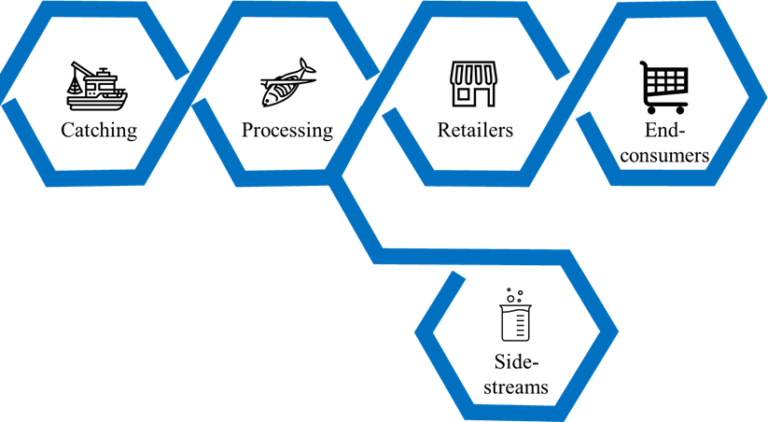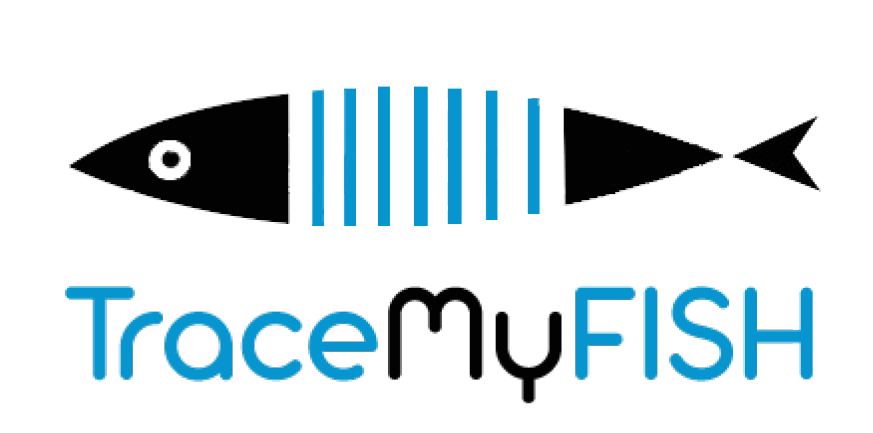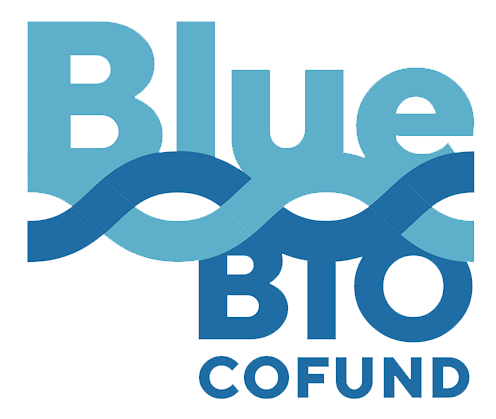The Atlantic whitefish value chain
Value chain definition
The Atlantic whitefish value chain is defined as the product flow from catch, mainly by trawlers or long-liners, through processing to the end customer, as well as connected side-streams (Fig. 1). The time from catch until the fish enters the processing plant take 2-5 days, depending on the distance from the fishing ground and weather conditions. A modern demersal fish processing plant focuses on producing fillets and fillet pieces from Atlantic whitefish (e.g., cod, redfish, and saithe). The fish is sized, decapitated, filleted, skinned, and trimmed before being cut into pieces according to the buyer ‘s criteria. The products are both exported fresh and frozen all year round. Fresh products are shipped the same day by air or in refrigerated containers by ship to foreign markets, while frozen products are exported in freezer containers or by pallet vessels. The fish enters the processing plant with a core temperature of approximately -1.5 °C (chilled by onboard RSW tanks) and it takes less than 40 minutes from when the fish enters the processing line until the fish is ready for export.
In addition to the fresh/frozen value chains a significant part of the total Atlantic whitefish ends as salted product, such as, e.g., lightly salted, or fully salted fish (e.g., bacalao). Producers of both fresh and salted products have shown interest in the TraceMyFish project, and the technological developments included in the project. Mapping of value chains from both fresh and salted Atlantic cod products will therefore be included in the project. Furthermore, producers of fish oil have also shown interest in applying the developed tools, and trials from the fish oil side stream value chains will therefore also be included.
Icelandic marine products were exported to 95 countries in 2020, around 80% of the total were sold to Europe which is the most important market for Icelandic seafood. Frozen products account for 44.1% of the export value of marine exports. The single most valuable fish species for Icelandic seafood exports is cod which accounted for 49% of the export value of marine products in 2020.

User requirements for non-destructive and destructive methods for tracing hazard
One of the main benefits of the Icelandic white fish value chains is that the raw material acquisition, and main processing are often owned by the same company, making tracking and tracing of the main products easier. Production equipment are most commonly produced by large scale producers, such as Marel or Baader, and often include associated data management and traceability software solutions, for automatic monitoring of basic parameters, such as generic catching data, and temperature and weight changes during production. Most production facilities have small quality assurance laboratories, where chosen physical and chemical quality parameters are tested on samples from each batch. For this testing, traditional physicochemical analytical methods are usually applied. These methods are often, sample destructive, expensive, time consuming, and may include the use of dangerous solvents or other chemicals. Although process automation is high during processing in the larger companies, producers call for more automation for quality assessment and monitoring.
Current quality assurance includes computer vision solutions, x-ray for bone and contaminant detection and removal, water cutting for portioning, automatic scales, etc. Adverse effects of contaminants (e.g., pathogenic bacteria, parasites, chemical contaminants, etc.) will be tested alongside the VideometerLite and VideometerLab solutions.
Tentative sampling protocol and analytical data aquisition
The experiment and sampling protocols that will be applied in the TraceMyFish project within the whitefish value chain are as follows:
- Fresh and frozen fillets: The main activities within the whitefish value chain will focus on the main production of fresh and frozen fillets. Samples will be taken regularly throughout the production to assess the quality changes
occurring during processing and to identify where adding the Videometer technologies will give the most representative quality assessment and where it gives most value to the production. Traditional physicochemical and microbiological assessments will be run alongside spectroscopical assessments, to allow the building and validation of potential spectroscopical or image analysis-based quality prediction models. Microbial counts, processing yield, chemical composition, near infrared (NIR) and time domain nuclear magnetic resonance (NMR) spectroscopy, colour, pH, texture, and water holding capacity assessments will be analysed as references. - Salted fish: Discussions with Vísir hf., which is a major producer of light and heavily salted cod products, showed that the company is interested in applying the Videometer technologies in their value chains. Value chains of chosen salted products (lightly or heavily salted products) will be analysed in detail. Salting leads to more extremes in chemical composition and physicochemical characteristics than the fresh and frozen fillet production does. Including the salted fish value chains are thus important since they increase the potential future applications of the Videometer technologies.

